No other library in the world today courts as much international awe and controversy as the Bibliotheca Alexandrina – the resurrected library of Alexandria that was unveiled ten years ago to commemorate its forebear lost in antiquity to a fire. A UNESCO project that started off as an idea by Alexandrian academics in the 1970s quickly gained pace with the aim of becoming “the fourth pyramid,” as the toppled president Hosni Mubarak put it, and endowing the “Mediterranean region with a center of cultural and scientific excellence.”
The project was bankrolled by the governments of Egypt, the Gulf, Europe, United States, Russia and international bodies. The Greeks aided in the area of antiquities, the French in the development of the science museum, and Americans for the computer systems and Internet archive. There was also a fair deal of ego investment, from the disproportionately high number of Francophone books donated by the French government (surpassing the combined total of such books in the former French colonies of Tunisia, Algeria and Morocco) to the clearly visible “From Greece” gift of the Alexander the Great statue on the library’s steps as a reminder -- not least to visiting Macedonian nationals -- as to who lays claim to the legendary founder of the city.
On 16 October, 2002, world dignitaries, including Queen Sophia of Spain and then-French president Jacques Chirac, descended for the inauguration of the Bibliotheca, as Mubarak and his wife, Suzanne, spoke of having returned a famed monument back to the pearl of the Mediterranean. It was a little over a year since the attacks of 11 September, 2001 in the United States and a few months before the Iraq War. The event provided a desperately needed reprieve from the seemingly impending “clash of civilizations” that was looming large on the world stage.
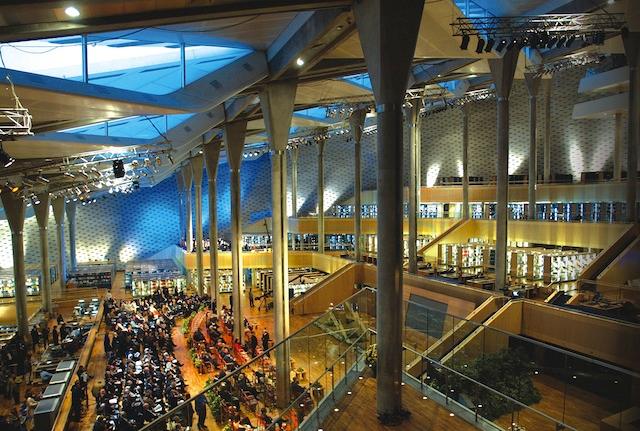
[Opening of the Bibliotheca Alexandria, 16 October 2012. Photo by Caryle Murphy.]
Contrast this grandiose scene of seated world presidents, monarchs, and other VIPs, amidst the tightest security the coastal city has ever witnessed in living memory, with what happened a decade later: in January 2012, in a moment not so peculiar to Egypt’s post-revolutionary upheaval, the controversial head of the Bibliotheca, Ismail Serageldin, was locked up in his office by four hundred library staff members and refused exit until he tendered his resignation. He phoned the army who arrived with a ladder to aid his escape through his fifth floor office window in a scene that has come to characterize an emboldened Egyptian workforce.
The odyssey of the Bibliotheca goes deeper than the Mubaraks’ grandstanding platitudes of the “melting pot” and “center that unites together the Arab, Islamic, and international heritages.” The library rests at the heart of international power plays seeking to carve out a stake in the “sacred drama” of the Alexandria myth, Egypt’s political repositioning with the West, the Mubaraks’ unabashed narcissism, coupled with the self-styled “culture wars” of Alexandria’s elites. The foundational drama that midwifed the Bibliotheca would give way to a decade of corruption, abuse of power, while also positively shaping the socio-cultural landscape of the coastal city, even making it a vital player in the post-Mubarak environment. Yet to understand any of this, one needs to go back to one warm afternoon in June 1974, when an unexpected guest showed up.
When Nixon came to town for some “cosmopolitanism-gate”
In her excellently researched work, Return to Alexandria: An Ethnography of Cultural Heritage Revivalism and Museum,[1] Beverley Butler interviewed the original proponent of the library project, Mostafa El Abaddi, Professor of Greco-Roman Studies at Alexandria University. Abaddi recounts a story when Richard Nixon, two months before his infamous resignation in 1974, visited Alexandria in which the president “displayed the interest that many foreigners do. He had an idealized image of Alexandria already formed in his imagination and obviously felt a certain affinity and a nostalgia for Alexandria’s Golden Age: its Greco-Roman, Hellenistic, and cosmopolitan pasts. This became particularly obvious when Nixon asked us if we could show him the site where the ancient ‘Universal’ Library…once stood.” Except no one knew where it stood.
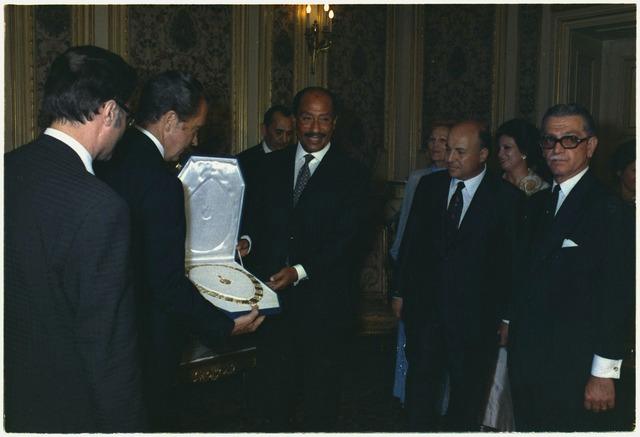
[Richard Nixon with Anwar al-Sadat on 12 June 1974. Photo by Robert Leroy Knudsen. From Wikimedia Commons.]
Such questions, whether at home or abroad, with presidents or with tourists, were not uncommon. Academics at Alexandria University, and the dispirited elites of the city, saw an opportunity to revive one of their long-standing ideas – resurrecting the library. They were long frustrated that the late President Gamal Abdel Nasser’s policy of centralization saw resources and cultural activity shift to Cairo, along with the flight of foreign communities, making the coastal city a shadow of its former self. Alexandria found itself in a post-1952 Republican Egypt; disoriented and with little to contribute in an era of Pan-Arabism and anti-colonialism, it had little heritage of the former and was implicitly the target of the latter due to its association with western Mediterranean (Greco-Roman) heritage. This was manifested, for example, in the diversion of funding to projects related to Arab and Pharaonic heritage – Cairo’s strength but Alexandria’s weakness. One older intellectual woman, projecting a not so uncommon Alexandrian insecurity, brashly stated to me “We were the leading cultural elites of this country.” Anecdotally, Alexandrians born pre-1952 are most likely to exhibit fondness for the monarchical era more than any other Egyptian population center.
Abaddi and his colleagues engaged in a strategic endeavor to bring the library back, as he unapologetically states: “We could make use of specific associations of the ancient library for propaganda purposes and…We found that playing the “cosmopolitan card” was useful, as it worked very well within UNESCO’s own interests and values.”[2]
In the late 1970s, they approached the Minister of Education Mostafa Kamal Helmy, appealing to his Alexandrian roots and sympathy to the project, to be able to get the idea to the attention of UNESCO in Paris. The UNESCO director general at the time, Ahmed Mukhtar Embu, was swayed and upon his visit to Alexandria in the late 1980s, stated: “If the project is implemented to the level of the idea which inspired it; it will be capable of changing the cultural map of the whole area.”[3]
The politicization of a library
Following a 1988 global design competition won by a Norwegian design, the Alexandrina project was seized from Abaddi and the scholars and usurped by a culture of politicians, bureaucrats, and diplomats operating within the mindset and framework of international and national domains. The scene that played out at the 1990 Aswan meeting to inaugurate the project, centered on President Mubarak and his wife, was one of theatrics that sucked the participants into a whirlpool of a “sacred drama” as Butler put it.
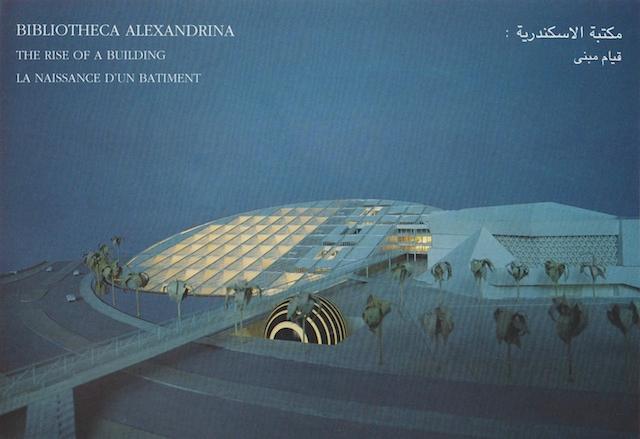
[Design of the Bibliotheca Alexandrina. Photo from Bibliotheca site.]
The list of international actors bought into the “ancient Alexandrina’s myth/history and redemptive formula” and attempted to outdo each other in their statements, from the likes of Queen Noor of Jordan’s “honoring our ancestors,” French President François Mitterrand’s “let us imagine the poets and thinkers, from all corners of the known earth, working together and cooperating with each other,” to the UNESCO Director-General Federico Mayor describing the historical loss as a “sobering reminder of how fragile the constructs of the civilized mind can be.” Mubarak, not to be outshone: “On the soil of Alexandria, the ancient Egyptian civilization met and merged with Greek, Roman, and Arab civilizations.” Rather than actual debate, the event was a descent into “Alexandria’s ancient imaginary”[4] and -- further entrenched by the overuse of buzzwords like universal origins, progress, revivalism, peace, democracy, humanity, enlightenment, and development – was part and parcel of the library’s foundational drama that served to evoke emotional responses and unchallengeable statements. In short, it was a diplomatic Woodstock.
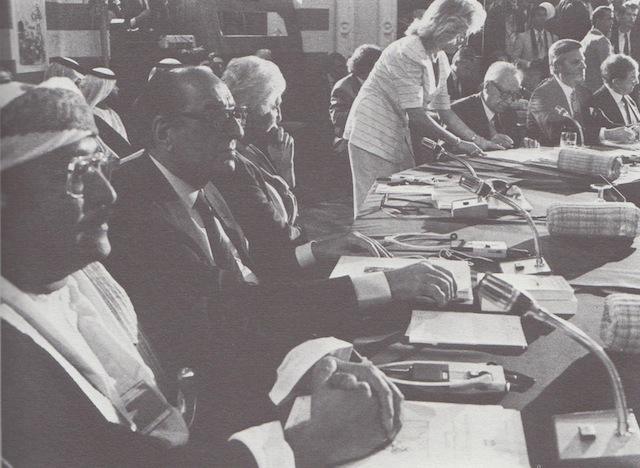
[Delegates at 1990 Aswan meeting. Photo from UNESCO.]
These theatrics, Butler argues, enabled nation-state leaders the means to acquire or further consolidate an identity as “High Priests” to their domestic constituencies as well as elevating their international stature. Moreover, their alignment with Egypt’s cultural heritage carried weight and potency that translated into the “apparel of ‘universal’ heritage, within highly `dramatized` and `moralizing` performances as a means for ‘actors’ to legitimate themselves within the UN/UNESCO’s universalizing, liberal, and democratic cosmopolitics of diversity and dialogue, even if ‘at-home’ authoritarianism may block the reality of exercising such ‘values.’”[5]
Ian McNeely and Lisa Wolverton in Reinventing Knowledge: From Alexandria to the Internet provide a compelling frame of reference to understand this fixation with the project:
The libraries they [Ptolemy’s] founded enabled knowledge to flourish for the first time in the radically different social environment of the Hellenistic empire. Since then, libraries have been supported by an astonishing variety of political systems down to the present day. Any institution that has lasted well over two millennia has to have appealed not just to scholars and academics but to society at large. It must have fulfilled some of the deepest aspirations of ancient people, reflected the wishes of those commanding influence and resources, and meshed with the structures of social and political power.[6]
This can be seen by the reaction of the Gulf states. Saudi Arabia, United Arab Emirates and Iraq pledged US$64 million.[7] But it was Saddam Hussein who upstaged the others, within twenty-four hours, gave the largest contribution of US$21 million to “claim his place to be the patron of world civilization/culture.”[8] Not surprisingly, the Iraqi delegation was given prime seating during the 2002 opening of the Bibliotheca (the Iraqi regime would be toppled six months later). (Click here to view a scanned copy of the Aswan Declaration in English, Arabic and French on my blog.)
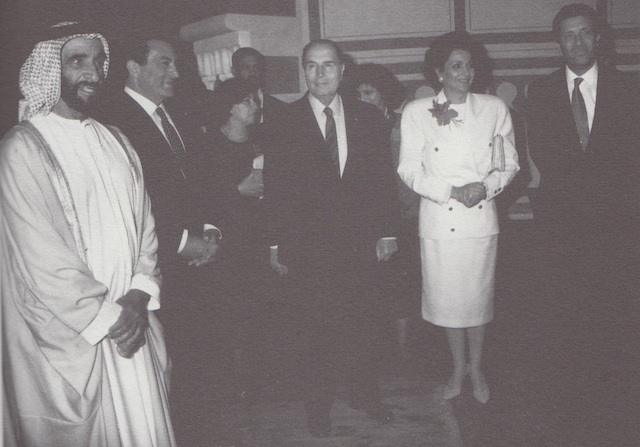
[Mubarak and Suzanne with heads of state. Photo from UNESCO.]
Yet what does this say about the aspirations of Mubarak given that he had no regional ambitions for Egypt, was no Nasser, and had a lackluster imagination that did not enable him to think too far? Mubarak was following in the footsteps of Sadat’s brief utilization of Alexandria as a bridge to the West; Mubarak strategically understood the library and city to be part and parcel of his cultural reconciliation with the West and promotion of “softer steps” towards “democracy.” Just as the Spanish city of Cordoba fires up the Arab imagination, as the Moorish city that came to represent the peak of Arab and Islamic civilization, Alexandria has a powerful hold over the Western imagination, the city seen to be, in large part, the metaphysical origin and blueprint of Western culture.
Rising from the ashes
During the later construction phase, I would often pass by, on my way to see relatives in the adjacent suburb of Azarita, to gawk at the rising sundial disc library for a good ten minutes. Though disappointed that I was overseas during the opening, I beamed with some shallow delight that at least it was being inaugurated on my birthday.
Someone who was there during the opening, Tarek, a student at Alexandria University at the time, describes the ecstatic feeling: “It was high joy for everyone, and seeing so many Alexandrians happy was infectious. It was like Alexandria was back on the map again. The library we had lost two thousand years ago had come back to us." Schools had shut down for three days, public transportation, due to the intense security, halted for the day, and celebrations continued roughly for a month.
Yet controversy marred it from the start. There were grumblings at the cost of US$220 million (US$70 million over-budget) that could have been better spent on other areas in a developing country like Egypt. Some worried that Alexandria’s crumbling infrastructure would not be able to live up to the monumental task of attending the needs and care of the UNESCO project. There was also widespread criticism that a regime built on censorship would stifle the creative spirit and literary content of the library.
Yet for all the talk of libraries around the world keen to donate books to their spiritual forebear, it became an international scandal when numerous libraries (possibly not knowing others were doing the same) seized the opportunity to offload obsolete books they did not want; upon its inauguration, the Bibliotheca was “graced” with books such as The Guide to British Directories, 1953 and the 1974 edition of the Guinness Book of Records.[9] It was also a major fiasco when Alexandria University sold its library collection the year before on the presumption the incoming catalogue of books at the Bibliotheca would be of a higher quality than what they had. It never was.[10]
Egypt and the literary world were almost given a two thousand year-rewind heart attack when a fire broke out in March 2003 on the fourth floor of the Bibliotheca. Twenty-nine people were treated for smoke inhalation but no book was affected. It is disturbing when rabid proponents describe the building as “fireproof” – forgetting the irony of what happened to a now-famous “unsinkable” ship exactly one hundred years ago.
Nevertheless, the library has been nothing short of impressive and continues to inspire me every time I step onto its grounds. As the Bibliotheca website states, it can hold up to eight million books (at the current rate of acquisition, would take several decades to fill). It includes an Internet archive, six specialized libraries, four museums, a planetarium, eight research centers, fifteen permanent exhibitions, four art galleries, a conference center, and is home to nine institutions including the Anna Lindh Foundation for Dialogue between Cultures, and the International Federation for Library Associations. One of the gems that never fails to bring me back constantly is the manuscript museum with its priceless collection covering “120 manuscripts and rare books in a multitude of languages including Arabic and Latin,” as well as the state of the art digital archives which is one of many crowning achievements of the Bibliotheca.
.jpg)
[Manuscripts Museum. Photo from Bibliotheca Alexandrina website.]
Amani Massoud, a former employee of the library from 2003 to 2007, remarks:
The library did an excellent job in shaping a new culture in the city. I have seen how the visitors’ attitude towards books and respecting the place has evolved over time. More and more students were coming in to actually read than to just hang out in this cool new place. The cultural and scientific events were diverse and enriching and brought to Alexandria many arts and performances that otherwise we would not have been exposed to.
It would not be until the 2011 January 25 Revolution that the library would experience its own uprising and string of scandals and revelations of the past decade would come out in full force.
Revolution and the “Regime” of Ismail Serageldin
The library was shut down during the 2011 eighteen-day uprising and it brought out countless youths to form a chain around to protect it, video footage of which awed the world.
Soon after the ouster of Mubarak, Egypt’s Illicit Gains Authority discovered US$145 million, intended for the library, to be in a bank account belonging to Suzanne Mubarak.

[Guarding the library during the eighteen-days.
Photo from Bibliotheca Alexandrina website.]
It was rare to find a ministry or institute in the Mubarak era that was not closely associated with personalities. For the Bibliotheca, no man inspired admiration and loathing as “Egypt’s most intelligent man” – Ismail Serageldin, a Harvard-educated intellectual with more degrees than the Dead Sea Scrolls.
Serageldin currently stands accused of squandering public funds and abusing his power. Serageldin was supposed to stand trial on 8 October, 2012, but his trial has been postponed to 12 November.
In March 2012, Australian journalist Jess Hill inserted a thorough investigative piece, “The Angry Librarians of Alexandria,” into the controversy. Hill poses to Serageldin “…Your employees are not contesting their wages…their most pressing concern is the quality of the library’s academic output.” Serageldin explodes at this. “What?! Please! Please! This is such total nonsense…The library is one of the most distinguished institutions in the world. We collaborate with the Library of Congress, the Smithsonian... For heaven’s sake, who are these people to discuss the academic output of the library? They know nothing about the academic output.”
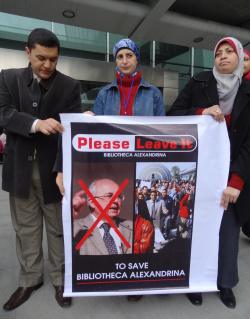
[Protesters against Seragaldin. Photo by Jess Hill.]
The reports on Serageldin’s character are consistent, as one person described him to me following an encounter: “A worldly, intelligent man, with a fair amount of self-entitlement on board. It seemed to me that he was very used to getting his own way, and did not hold people who disagreed with him in very high esteem.” A glance at his speeches and Twitter feed seems to support the view of a pontificating director.
Massoud, who worked as Research Assistant to Serageldin (October 2006 to August 2007), tends to be more sympathetic:
I have nothing but the highest regards for him. People may disagree on many things surrounding him but the man is a genius. I am yet to meet someone with his intellectual capabilities…I sincerely believe no other person would have been capable of turning the library, in a very short span of time, into the place it became. If it were not for him I can only imagine the library turning into yet another equally unpromising government institution.
When I asked Massoud to explain all the hostility towards the director, she responds:
The main problem with the library was that it was not an institution as much as it was one person, which is Serageldin. All the department heads seemed to work towards impressing and pleasing him. That would differ from one manager to the other…there was no fair salary framework and the differences [in pay] were shocking. That alone is sufficient to create a lot of resentment. There was a lot of internal favoritism when it came to promotions or travel and privileges and there was a lot of financial low-scale corruption. The kind that would go unnoticed but collectively amounts to a lot. Some managers for example would do personal trips and record them down as business trips getting all the compensation that comes with it. Working hard was not always the road to success and promotion but there were a lot of other factors involved.
Aly El Raggal’s critiques are less compromising than those of Massoud. Having briefly worked in the heated days of the Bibliotheca in 2011, he resigned in anger at the director, and told me: “Let’s face it, Serageldin brought to the Bibliotheca an elite driven non-inclusive discourse with talks of enlightenment and rationalization that recreates social divides. Also, being picked by the first lady was no surprise.”
It is not uncommon to come across sympathizers who argue that the director’s association with the former first lady was imposed, and that the only way he could acquire such a position was through her. As Massoud states: “The only way he could have avoided that is if he had turned down the job to start with.” Raggal shoots back: “He is, after all, the former vice-president of the World Bank. He was handpicked because of his neoliberal views that were compatible with the Mubarak regime’s programs.”

[With Mubarak`s portrait overseeing them, Serageldin with former first lady Suzanne Mubarak at an event convened at the Bibliotheca in January 2007. Photo from childfamily.gr]
Raggal argues that Serageldin was integral to the former regime yet chose to play up revolutionary credentials despite his authoritarian-style behavior. Raggal points to the commencement of Serageldin’s administration of the Bibliotheca at a time the privatization movement took control of business life in Egypt. These were the days when the World Bank was urging the opening of markets, economic restructuring and liberalization of the economy, in addition to American neoliberal policies that countries such as Egypt were pressured to adopt. In this environment, the rich-poor gap grew wider. Also combined with the corruption and favoritism plaguing the library, this led to a stratified environment. As Massoud points out: “When I first worked at the library, with a Master’s degree, I was paid less than 1000 EGP when others, whether in the same department or in other departments would get ten times as much.”
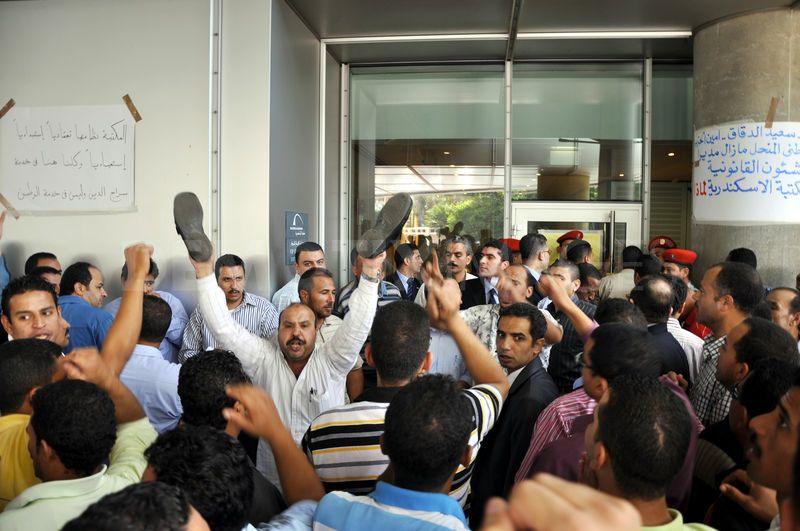
[Alexandria Library staff protest for the dismissal of Serageldin. Photo by Ahmed Tarek.]
Raggal points out that there was a clear connection between the rules and procedures governing the World Bank and those governing the library and other organizations in Egypt. He also stresses that Serageldin adopted the same economic approach of the World Bank and the same political approach to guide and strengthen the interests and system led by Mubarak and his cronies in the National Democratic Party (NDP).
I further asked Raggal to clarify how the library as an institution could sustain the system. He responded boldly:
The library became one of the most important pillars of this corrupt system in the practice of so-called soft power by some of its NDP oriented youth conferences, but it also solidified questionable economic relations and interests. It is no coincidence, for example, that Medicare and health insurance services for the library’s employees were owned by NDP figure Hossam Badrawi. So what we see is a network of corrupt power relations working seamlessly through organizations and companies, and the Bibliotheca, which was supposed to be a center for development, civilization and what not, is made a mockery of.
In a surreal twist of fate packed with ironies, a two-day conference at the Bibliotheca took place on 16 June, 2010 that illustrated a profound divide between the institute and Egyptian society. The conference, titled “A New Beginning: US-Muslims Relations,” (in hindsight, quite premature given the Arab uprisings were six months away) was quite telling because it came just ten days after Khaled Saeed’s death – the young Alexandrian who was beaten to death by policemen and would spark the swift countdown to the 2011 Egyptian Revolution (See my Jadaliyya piece on Khaled’s life and death: Saeeds of Revolution: De-Mythologizing Khaled Saeed). A large number of silent protesters in black formed a chain outside the grounds to protest Khaled’s death and the hated emergency laws. Georgetown University media scholar Adel Iskandar, a guest at the conference, noted that security was so tight that it was made extremely difficult for international delegates to be a privy to the historic youth protest movement. Moreover, the library`s facilities themselves were practically off limits to members of the public to ensure the public protest movement unfolding outside would not spill over into the library. Incidentally, there were four tracks in the conference, namely Youth, IT, Media, and Women – four crucial components that would be integral to the dynamics of the revolution that was soon to come.
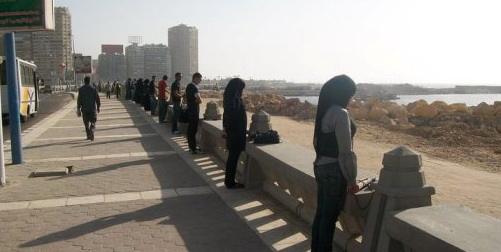
[Silent protest stand for Khaled Saeed in 2010. Photo from Elshaheed Facebook page.]
On the panel was a young woman attendee who brought up the protests outside the venue as an example of youth empowerment. This was followed by a chilling silence by those present. As Iskandar aptly put it, "catatonia had struck." No one spoke – agreeing with her would translate into a political statement against the sitting government, essentially the hosts of the event. Speaking against her would appear as an endorsement of police brutality. The comment dissipated into the auditorium’s air – the usual international indifference towards the Mubarak regime’s brutal human rights record.
I queried Iskandar as to what degree could Serageldin be responsible for the atmosphere of censorship, given it was “normal” policy and practice at the time. He said: “He certainly did not jump up and personally shut people up, it was simply clear that no discussion of politics was permissible. He may not have necessarily micromanaged the event, because he did not need too – Serageldin is not just a person, he is a regime.”
A former intern who spoke on condition of anonymity stated: “One of the anecdotes that we were told when we started was that there was a retreat every year where all the heads of departments would convene, discuss the plans, etc. That was at the beginning [of Bibliotheca’s early days]. Along the years it has become a two-day retreat where nobody but Serageldin only speaks for two straight days.”
Massoud urges the need for the library to create a separate identity from the one entangled with Serageldin. She voiced an ominous concern: “My fear was always that the place will stop running if he ever decided to leave and that fear still holds. More effort needs to be put into ensuring a skilled efficient staff and mechanisms to turn the place into a self-running institution that does not count on the director`s name for success.”
Radwa, a former intern at the library, lamented: “The library`s lack of outreach to the Alexandrian community, although many employees want to do that but for some reason their attempts have not been successful. I can attest that there are some creative and very dedicated people with brilliant ideas and initiatives but suffer from the narrow mindedness of their bosses who are not keen to innovate.” Both Radwa and Massoud concur that the library is very overstaffed, which is creating many of the inefficiencies in the system.
How the Library Shaped Alexandria’s Social Landscape
Despite all the criticisms of the library, I can say, from personal experience with youth groups, the social changes it promoted are immeasurable. Considerably, the library has become an agent of socialization that is shaping Alexandria’s sense of self and social identity. It helps the young to better appreciate reading and the arts, realize their human capacities and negotiate the social and physical environment they have inherited.[11] This is because the library, like mosques and churches, is integrating itself into the social structure of Alexandria, and by extension, Egypt. It can therefore aid the youth in reinterpreting and reconstituting their role in post-revolutionary Egypt. Importantly, it plays a vital ideational counterbalance to conservative Islamist trends in the coastal city.
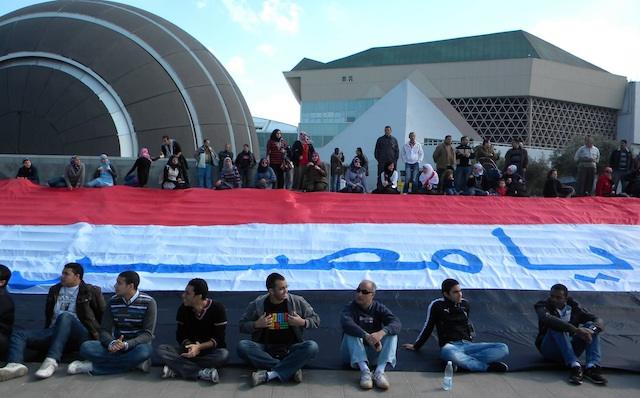
[Protesters gathered by Bibliotheca Alexandrina on 11 February 2011 demand
the resignation of Mubarak (he would do so that evening). Photo by Mohamed Hossny.]
While some criticize the library for not having fulfilled the dream of reviving robust scholarship, that is too much to expect in a mere decade. The dearth of scholarship is partly a byproduct of a dysfunctional education system that is in dire need of reform. (I partly address this question in my September piece, Turning the Tide on Egypt’s Sinking Book Reading Culture.) Despite this limitation, the library has done quite remarkable work in the context of the revolution. It has held seminars, debates, workshops and symposiums on how to move Egypt forward. Where the education system churns out rote learners, the Bibliotheca’s events are aimed at nurturing critical thinkers. Significantly, when Napoleon’s institute burnt in Cairo amidst protests in December 2011, it was the Bibliotheca team that was sent out to recover manuscripts and undertake a process of restoration.
The sacred drama played out in the 1990 elite-saturated Aswan meeting has been acquisitioned by much of the youth and Egypt’s growing civil society. They have taken Queen Noor’s “honoring our ancestors” and transformed it into “honoring our descendants.” A progressive outlook shapes their role and activity in Egypt’s future. This was not just marked by their reaction to the upheaval of the revolution’s eighteen days and the human chain they formed around the library, but until this day, the Bibliotheca forms a crucial venue for activists, protesters, scholars, artists, musicians and students, and not to mention the new type of tourist – the “book tourist.” The library acts as the soul of the revolutionary youth community and civil groups. It also plays an inadvertent role in influencing the style and content of the protests that congregate in the nearby courtyard of Qaed Ibrahim Mosque (or as some call it, “Alexandria’s Tahrir Square”). The library’s location alongside the colleges of arts, law and commerce enhances the creativity and refinement of the protest movements.
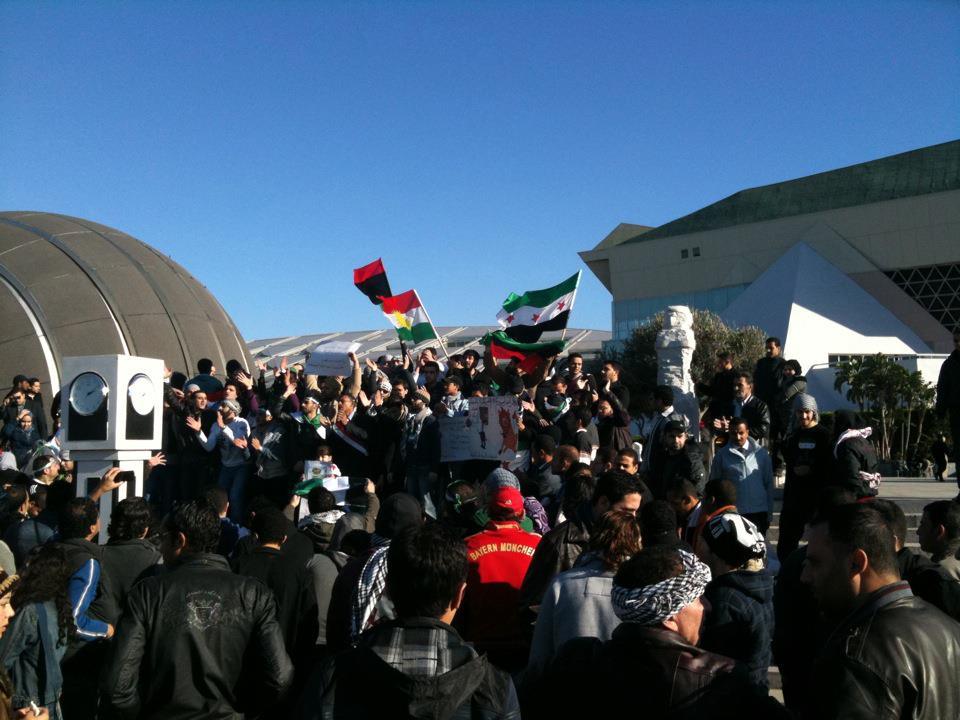
[Syrian activists gather outside the Bibliotheca to rally support for the Syrian Revolution. Photo by Amro Ali.]
The cynics will continue to worry about the library’s future from the likes of President Mohamed Morsi and his group, the Muslim Brotherhood. Yet the Bibliotheca Alexandrina, as Tarek notes, will continue to “underpin the civic spirit, and be above the problems that divide Egyptian society, and I believe the library will greatly help lay the crucial cultural groundwork for Egypt as it transitions towards democracy, pluralism, freedom to think and so on. It will take time, but the library will only get stronger and more dynamic in the new Egypt.” The Brotherhood is just but one actor on the stage, a dominant one for sure, but Egypt is bigger than Morsi and his affiliates, and Alexandria – which voted overwhelmingly for a secular-leaning presidential candidate Hamdeen Sabahi – is becoming much more socio-politically diverse. The library is clearly reflecting such trends and there is an international stake to allow it to continue in that manner. The talented array of staff members now see their roles as performers of checks and balances against any corrupt practices, and they are not afraid to march in their hundreds up against the “smartest man in Egypt.” When all is said and done, the Bibliotheca will outlive the Mubaraks, Serageldins and Morsis.
The poet Jorge Luis Borges once lamented: “I, who had always thought of Paradise in form and image as a library.” That “paradise”, in many respects, has returned to Alexandria – with a new script, new actors, and, this time, a more compelling sacred drama.
[1] Beverley Butler, Return to Alexandria: an ethnography of cultural heritage, revivalism, and Museum History (Walnut Creek: Left Coast Press Inc., 2007)
[2] Ibid., 97.
[3] Ibid., 98.
[4] Ibid., 121-22.
[5] Ibid., 110.
[6] Ian F. McNeely, Lisa Wolverton, Reinventing Knowledge: From Alexandria to the Internet (New York: W.W. Norton & Company Inc.: 2008) 5.
[7] GOAL 1990. Bibliotheca Alexandrina: Record of the Inaugural Meeting of the International Commission for the Revival of the Ancient Library of Alexandria, Aswan, 11-12 February 1990. Alexandria: Goal Publications. 7.
[8] Butler, Return to Alexandria, 121.
[9] MacFaruhar, R. 2001. Shadow of a Library, The New York Times 11/5/01:20
[10] Butler, Return to Alexandria, 183.
[11] Joan Ferrante, Sociology: A Global Perspective (Belmont: Wadsworth, 2012), 91.